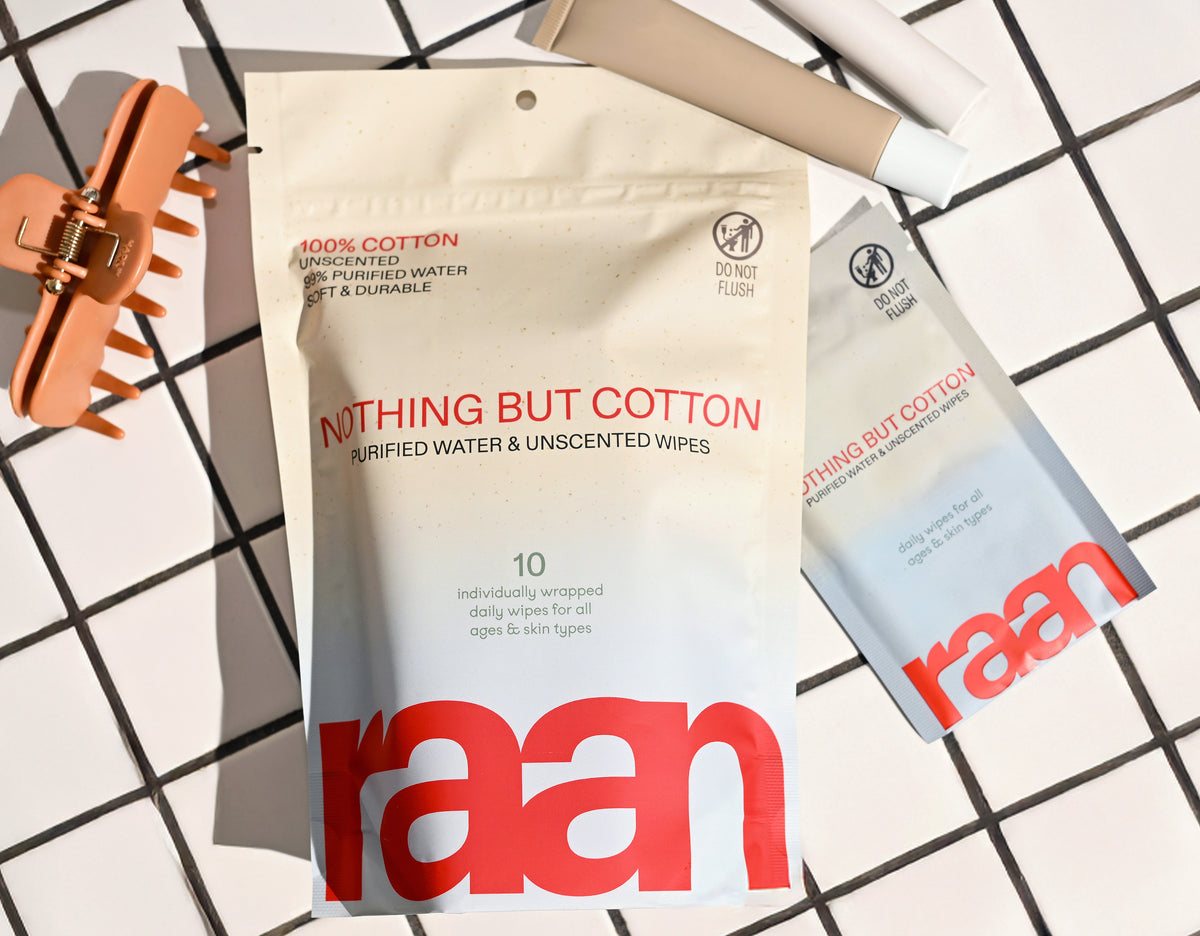Key Takeaways
- The best newborn bathing products prioritize safety, ingredient integrity, and genuine functionality over marketing claims.
- Newborn skin is 30% thinner than adult skin, making it more sensitive to harsh ingredients.
- Developing pH barriers in newborns can be disrupted by synthetic preservatives, plastic fibers, and unnecessary fragrances.
- Choosing products with gentle, science-backed formulations is essential for protecting delicate newborn skin.
Table of Contents
- What "Best" Means for Newborn Bathing: Defining Safe, Honest, Functional Care
- The First Bath: When, How, and Why Timing Matters for Newborns
- Sponge Bath vs. Tub Bath: Choosing the Right Method for Your Baby's Stage
- Must-Have Newborn Bathing Supplies, What You Really Need (and What to Skip)
- Decoding Ingredients: How to Read, and Trust, a Baby Bath Label
- Product Comparison: Fragrance-Free vs. Scented, Conventional vs. Truly Gentle
- Step-by-Step: Giving Your Newborn a Safe, Soothing Bath at Any Stage
- Newborn Bathing Products, What to Avoid, and Why It's (Sometimes) Complicated
- Growing With Your Baby: When and How to Update Your Bath Routine
- Bathing for Sensitive, Dry, or Problem Skin: Practical Advice and Product Solutions
- Sustainability Meets Everyday Use: Packaging, Waste, and the Honest Impact of Your Choices
The Science, and Simplicity, Behind the Best Newborn Bathing Products
Finding the best newborn bathing products means cutting through marketing noise to focus on what actually matters: safety, ingredient integrity, and real functionality. Your newborn's skin is 30% thinner than adult skin, with a developing pH barrier that can be disrupted by synthetic preservatives, plastic fibers, and unnecessary fragrances found in conventional products.
We've tested formulations, analyzed certifications, and compared ingredient lists to identify products that meet the highest standards for newborn care. The winners share common traits: minimal, transparent ingredients, third-party safety verification, and materials that work with, not against, your baby's natural skin development. For parents seeking the purest option, the only unbleached, 100% cotton baby wipe for sensitive skin stands out for its uncompromising simplicity and safety.
To cover every scenario from at-home baths to on-the-go cleanups, consider adding a pocket wipe for sensitive skin to your essentials. These individually wrapped wipes are ideal for travel or diaper bags, ensuring gentle care is always within reach.
What "Best" Means for Newborn Bathing: Defining Safe, Honest, Functional Care
The best bath products for newborns aren't determined by packaging claims or price points, they're defined by measurable safety standards and ingredient transparency. EWG Verified products undergo rigorous testing for skin safety, while dermatologist-tested formulations provide clinical backing for sensitive skin compatibility.
Safety Benchmarks That Matter
- EWG Verified: Independent testing for skin irritants and toxicity
- Hypoallergenic: Clinically tested to minimize allergic reactions
- pH-balanced: Formulated to match newborn skin's natural 5.5-6.5 pH range
- Fragrance-free: No synthetic or natural fragrances that can trigger sensitivity
Common marketing terms like "gentle" and "natural" lack regulatory standards, making them unreliable indicators of safety. Instead, look for specific certifications and ingredient transparency. Products with fewer than 10 ingredients typically pose lower risk for sensitive newborn skin, as each additional component increases the potential for adverse reactions.
The gold standard combines minimal formulation with maximum transparency, like Raan's five-ingredient wipes made from unbleached, 100% cotton with only EWG-verified components. This approach eliminates guesswork and reduces the ingredient load on developing skin barriers. For more guidance on choosing the safest options, you can explore this best baby wipes for newborns resource.
The First Bath: When, How, and Why Timing Matters for Newborns

Medical research supports delaying your newborn's first bath for at least 6-24 hours after birth. The World Health Organization recommends waiting 24 hours to preserve vernix caseosa, the waxy coating that provides antimicrobial protection and helps regulate body temperature.
Vernix contains natural moisturizers and antimicrobial peptides that support your baby's developing skin microbiome. Rushing to wash it away can disrupt this protective barrier, potentially leading to increased skin dryness and irritation in the following weeks.
First Bath Readiness Checklist
- Umbilical cord stump has fallen off naturally (7-14 days)
- No signs of infection around cord area
- Baby is alert and calm, not hungry or overtired
- Room temperature is 75-80°F with minimal drafts
- All supplies gathered within arm's reach
Until the umbilical cord stump heals completely, stick to sponge baths using minimal water and gentle, fragrance-free products. The cord area should stay dry and clean, avoid submerging it in water, which can delay healing and increase infection risk. For more on this topic, see our detailed guide on sponge bath techniques and tips.
Sponge Bath vs. Tub Bath: Choosing the Right Method for Your Baby's Stage
Sponge baths are mandatory for newborns with unhealed umbilical cords, but they're also practical for nervous first-time parents who want to build confidence before transitioning to tub baths. The key difference lies in water exposure and your ability to maintain control.
| Method | Best For | Water Temperature | Duration | Key Benefits |
|---|---|---|---|---|
| Sponge Bath | Cord stump present, nervous parents | 98-100°F | 5-10 minutes | Complete control, minimal mess |
| Tub Bath | Healed cord, confident parents | 98-100°F | 5-15 minutes | Thorough cleaning, sensory experience |
For sponge baths, use a soft washcloth with warm water and minimal product, one gentle wipe or a drop of fragrance-free cleanser covers the entire body. Focus on face, neck creases, hands, and diaper area while keeping the rest of your baby covered and warm.
Tub baths require 2-3 inches of water and constant hand support. Never leave your baby unattended, even for seconds. The transition typically happens naturally around 2-3 weeks when parents feel more confident handling their baby.
Must-Have Newborn Bathing Supplies, What You Really Need (and What to Skip)
The difference between truly essential bathing supplies and marketing-driven "must-haves" becomes clear when you focus on function over flash. New parents need products that work reliably, use safe ingredients, and simplify rather than complicate bath time.
The actual essentials: A supportive baby bathtub or clean sink, soft cotton towels, gentle washcloths, and versatile wipes for quick cleanups. Everything else, specialized soaps, bath thermometers, elaborate bath seats, falls into the "nice but not necessary" category. The best newborn bathing products prioritize skin safety and parent confidence over bells and whistles.
| Essential Item | What to Look For | What to Skip | Why It Matters |
|---|---|---|---|
| Baby Bathtub | Non-slip base, appropriate size, easy to clean | Electronic features, built-in toys | Safety and simplicity over entertainment |
| Towels | 100% cotton, generous size, soft texture | Synthetic blends, rough textures | Natural fibers are gentler on delicate skin |
| Washcloths | Soft cotton, multiple for rotation | Textured or exfoliating varieties | Newborn skin needs gentle touch |
| Wipes | Minimal ingredients, unbleached cotton, EWG verified | Plastic fibers, fragrances, complex formulas | Fewer additives mean less irritation risk |
Raan wipes exemplify this essentials-focused approach with unbleached, 100% cotton material and just five EWG-verified ingredients. Unlike conventional options packed with synthetic preservatives and plastic fibers, they handle everything from gentle face cleaning to post-meal cleanups without overwhelming delicate skin with unnecessary additives. If you want a convenient bundle for every mess, the mess-ready pack is a practical choice for busy parents.
Decoding Ingredients: How to Read, and Trust, a Baby Bath Label

Reading ingredient lists becomes intuitive once you understand the basic principle: shorter lists with recognizable components typically indicate safer formulations. The best newborn bathing products list ingredients in order of concentration, starting with the most abundant, usually water, and working down to preservatives and pH adjusters.
Red flag ingredients to avoid: Sodium lauryl sulfate (SLS) and sodium laureth sulfate (SLES) create harsh foaming action that strips natural oils. Phthalates, often hidden under "fragrance," can disrupt hormone function. Parabens (methylparaben, propylparaben) preserve products but may cause skin sensitivity. Plastic fibers in wipes create microplastic waste and rougher texture against skin.
Compare this complexity to Raan's transparent five-ingredient formula: purified water (99% of the solution), food-grade preservatives (sodium benzoate, potassium sorbate), skin-conditioning ethylhexylglycerin, organic aloe for moisture, and citric acid for pH balance. Each ingredient serves a clear purpose without synthetic fragrances, dyes, or plastic components.
Ingredient transparency test: Can you pronounce and understand what each component does? If a brand can't explain their ingredients in plain language, that's often a sign of over-engineering or ingredient masking. Legitimate gentle formulations don't require complex chemistry, they rely on proven, minimal components that work synergistically without overwhelming newborn skin.
Product Comparison: Fragrance-Free vs. Scented, Conventional vs. Truly Gentle
True fragrance-free products contain zero added scents, masking agents, or aromatic compounds, a crucial distinction from "unscented" products that may use masking fragrances to neutralize natural ingredient odors. For newborns, fragrance-free eliminates a major source of skin irritation and respiratory sensitivity.
The "gentle" label appears on countless products, but meaningful gentleness requires ingredient restraint and third-party verification. Conventional wipes often contain 10-15 ingredients including synthetic preservatives, plastic fibers for durability, and chemical softeners. These additions may extend shelf life and reduce manufacturing costs, but they increase the likelihood of skin reactions in sensitive newborns.
Material Matters: Plastic-based wipes feel different against skin and create environmental waste, while unbleached cotton provides natural softness and biodegradability. The texture difference is immediately noticeable, cotton wipes feel more like soft fabric, while synthetic options can feel slippery or rough.
Raan's approach eliminates these compromises entirely. The unbleached, 100% cotton construction provides natural antibacterial properties without chemical treatments. The 70% plastic reduction in packaging reflects the same minimalist philosophy, less waste, fewer synthetic materials, more focus on what actually benefits your baby's skin and your family's values. For a complete starter kit, the starter set is an excellent way to begin your gentle care routine.
Step-by-Step: Giving Your Newborn a Safe, Soothing Bath at Any Stage
Successful newborn baths follow a predictable rhythm that prioritizes warmth, security, and efficiency. Start by gathering all supplies within arm's reach, towels, wipes, clean clothes, because you'll never leave your baby unattended, even for seconds.
Water preparation: Fill the tub with 2-3 inches of water at 98-100°F (37-38°C). Test the temperature with your wrist or elbow, it should feel warm, not hot. Keep the room draft-free and comfortably warm.
Bathing steps:
- Undress your baby, leaving the diaper on for now, and wrap them in a soft towel.
- Gently clean the face with a damp, soft washcloth or a gentle wipe, no cleanser needed for this step.
- Unwrap one section at a time, cleaning neck folds, arms, and hands, then legs and feet.
- Remove the diaper and clean the diaper area last, using a fresh wipe or washcloth.
- If using a tub, always support your baby's head and neck, and never let go.
- Pat skin dry with a clean, unbleached cotton towel, avoid rubbing.
- Dress your baby promptly to keep them warm.
Keep bath time brief, 5 to 10 minutes is plenty for newborns. If your baby seems cold or fussy, end the bath early and try again another day. Consistency and gentle handling help build positive associations with bath time.
Newborn Bathing Products, What to Avoid, and Why It's (Sometimes) Complicated

The ingredients that cause the most trouble for newborn skin aren't always the obvious ones. While most parents know to skip harsh soaps, the real culprits often hide in plain sight, synthetic preservatives in "gentle" wipes, bleaching agents in cotton products, and plastic fibers that leave microscopic residue on delicate skin.
Ingredients to skip entirely: Alcohol-based cleansers dry out newborn skin's protective barrier. Sodium lauryl sulfate (SLS) and sodium laureth sulfate (SLES) create foam but strip natural oils. Phthalates, often unlisted under "fragrance," disrupt hormonal development. Parabens accumulate in tissue over time.
The complication? Many products marketed as "baby-safe" still contain these additives. A wipe labeled "hypoallergenic" might use synthetic preservatives that cause contact dermatitis. Cotton washcloths can be bleached with chlorine, leaving chemical residue that irritates sensitive areas.
Hidden irritant alert: Fabric softener residue on towels and washcloths causes more newborn skin reactions than most bath products. Wash all baby linens with fragrance-free, dye-free detergent only.
Even "flushable" wipes contain plastic fibers that don't break down, and they're not safe for newborn skin either. These synthetic materials can cause micro-abrasions and leave residue that builds up over time.
The safest approach: choose products with complete ingredient transparency, like Raan's five-ingredient formula, and avoid anything that lists "fragrance" without specifying the source compounds. For a deeper dive into this topic, check out our article on the best wipes for newborns.
Growing With Your Baby: When and How to Update Your Bath Routine
Your newborn's bathing needs shift dramatically in the first few months. The biggest change happens when the umbilical cord stump falls off, usually 1-3 weeks after birth, opening the door to full tub baths instead of sponge baths only.
By 2-3 months, babies develop better head control and can sit with support, making bath time less precarious. This is when you can introduce a baby bath seat and slightly deeper water for more thorough cleaning.
Key transition markers: Increased drooling around 3-4 months means more frequent face cleaning. When babies start reaching for objects around 4-5 months, they'll get messier hands that need gentle but effective cleansing. The introduction of solid foods around 6 months creates entirely new cleaning challenges.
Your product needs evolve too. While newborns need minimal cleansing, older babies benefit from slightly more robust formulations, but still gentle enough for daily use. This is where versatile products like Raan wipes prove their worth, working effectively from newborn stage through toddlerhood without requiring formula changes.
Frequency adjustments: Newborns rarely need daily baths unless they have severe diaper blowouts. By 6 months, as babies become more active and eat solid foods, daily cleaning becomes necessary, though full baths can still be every other day.
The key is recognizing when your current routine isn't meeting your baby's changing needs, then adjusting gradually rather than overhauling everything at once. For evidence-based guidance on infant bathing routines, see this evidence-based guideline for infant bathing.
Bathing for Sensitive, Dry, or Problem Skin: Practical Advice and Product Solutions
Sensitive newborn skin requires a completely different approach to bathing, less frequent, shorter duration, and ultra-minimal products. Signs your baby has sensitive skin include persistent redness, rough patches, or reactions to products that work fine for other babies.
For eczema-prone skin, pediatric dermatologists recommend bathing every 2-3 days maximum, using lukewarm (not warm) water, and limiting bath time to 5-10 minutes. The goal is cleansing without stripping the skin's natural protective barrier.
Product selection for sensitive skin: Choose wipes and cleansers with the fewest possible ingredients. Raan's five-ingredient formula, 99% water and organic aloe, provides effective cleaning without common irritants like synthetic preservatives or fragrances that trigger flare-ups.
Sensitive skin protocol: Pat skin dry instead of rubbing, apply moisturizer within 3 minutes of bathing while skin is still damp, and use unbleached cotton towels washed in fragrance-free detergent.
For cradle cap, avoid the urge to scrub. Instead, use gentle wipes to soften scales before carefully brushing with a soft-bristled brush. Never pick or forcefully remove scales, as this can cause infection.
Dry skin benefits from adding moisture to bath water, but skip bubble baths or oils that can cause slipping hazards. Instead, focus on immediate post-bath moisturizing with products specifically formulated for infant skin. For more tips, see our recommendations for the best dry skin moisturizer for babies.
When dealing with diaper rash, use extra-gentle wipes like Raan that won't further irritate inflamed skin, and ensure complete drying before applying barrier cream. For additional clinical insights, review this medical research on newborn skin care.
Sustainability Meets Everyday Use: Packaging, Waste, and the Honest Impact of Your Choices

Most baby wipes come in hard plastic containers that parents keep long after the wipes are gone, but these containers represent unnecessary waste when simpler packaging works just as well. Raan's flexible pouch design uses 70% less plastic than traditional wipe containers while maintaining product freshness.
The difference is significant: conventional wipe packaging often includes virgin plastic lids, synthetic labels, and non-recyclable composite materials. Raan's approach uses a pouch with 35% post-consumer waste and skips the hard plastic lid entirely. Our boxes are 100% recyclable, making it easier to reduce your family's environmental footprint without sacrificing convenience or product integrity.
Choosing products with honest, minimal packaging is one of the simplest ways to reduce waste in your daily routine. When you opt for unbleached, 100% cotton wipes in a pouch that uses less plastic, you're making a choice that's better for your baby and the planet, without any extra effort.
Frequently Asked Questions
Why is it important to choose fragrance-free and pH-balanced products for newborn bathing?
Newborn skin is delicate and still developing its natural barrier, making it sensitive to irritants. Fragrance-free and pH-balanced products help avoid unnecessary chemicals that can disrupt this barrier, reducing the risk of irritation and supporting healthy skin development.
What safety certifications should parents look for when selecting newborn bathing products?
Parents should look for certifications like EWG Verified, Cruelty Free, and Natural Cotton Seal. These indicate that products meet strict safety and transparency standards, use gentle ingredients, and avoid harmful chemicals, ensuring trustworthy care for newborn skin.
How do synthetic preservatives and fragrances affect a newborn's developing skin barrier?
Synthetic preservatives and fragrances can interfere with the newborn's fragile skin barrier by causing irritation or disrupting its natural pH balance. This can lead to dryness, sensitivity, and make the skin more vulnerable to environmental stressors.
When should parents consider updating their newborn's bath routine and products as the baby grows?
Parents should revisit their baby's bath routine as skin changes with age, typically around the transition from newborn to infant stages. Adjusting products to match evolving skin needs, such as introducing mild cleansers or wipes suited for more active skin, helps maintain gentle, effective care.






